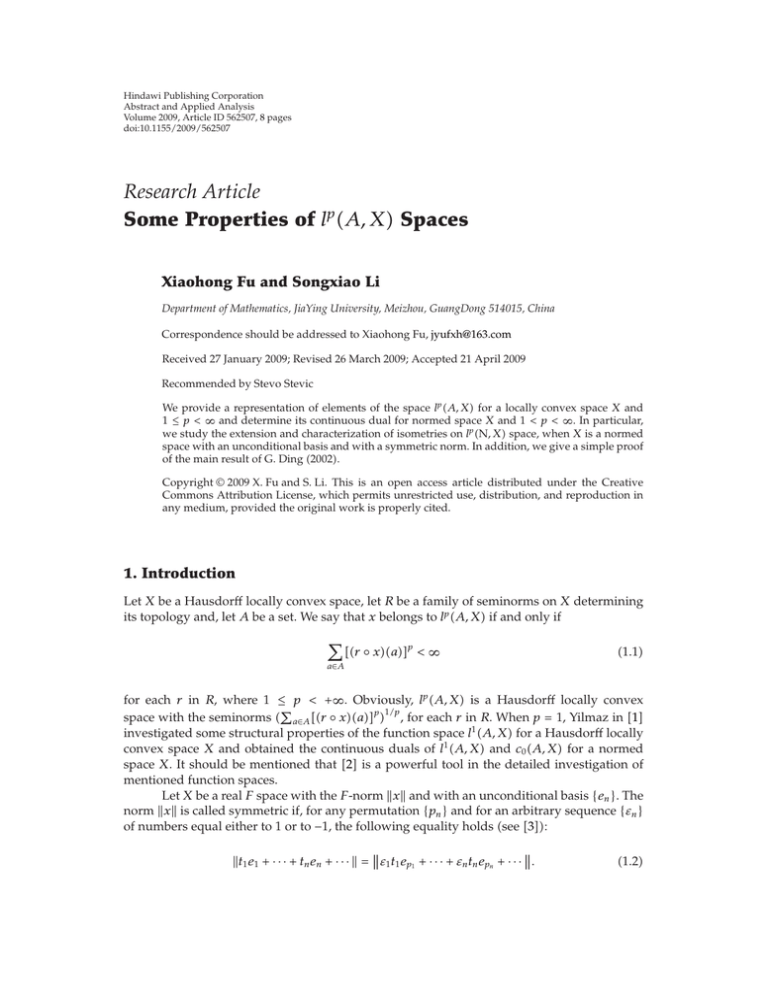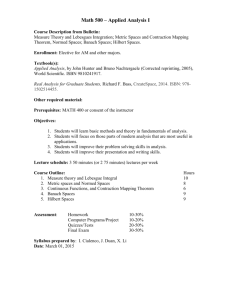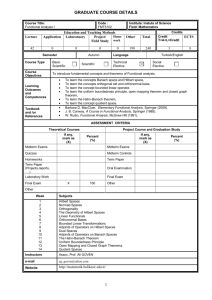Document 10817480
advertisement

Hindawi Publishing Corporation
Abstract and Applied Analysis
Volume 2009, Article ID 562507, 8 pages
doi:10.1155/2009/562507
Research Article
Some Properties of lp A, X Spaces
Xiaohong Fu and Songxiao Li
Department of Mathematics, JiaYing University, Meizhou, GuangDong 514015, China
Correspondence should be addressed to Xiaohong Fu, jyufxh@163.com
Received 27 January 2009; Revised 26 March 2009; Accepted 21 April 2009
Recommended by Stevo Stevic
We provide a representation of elements of the space lp A, X for a locally convex space X and
1 ≤ p < ∞ and determine its continuous dual for normed space X and 1 < p < ∞. In particular,
we study the extension and characterization of isometries on lp N, X space, when X is a normed
space with an unconditional basis and with a symmetric norm. In addition, we give a simple proof
of the main result of G. Ding 2002.
Copyright q 2009 X. Fu and S. Li. This is an open access article distributed under the Creative
Commons Attribution License, which permits unrestricted use, distribution, and reproduction in
any medium, provided the original work is properly cited.
1. Introduction
Let X be a Hausdorff locally convex space, let R be a family of seminorms on X determining
its topology and, let A be a set. We say that x belongs to lp A, X if and only if
r ◦ xap < ∞
1.1
a∈A
for each r in R, where 1 ≤ p < ∞. Obviously, lp A, X is a Hausdorff locally convex
1/p
space with the seminorms a∈A r ◦ xap , for each r in R. When p 1, Yilmaz in 1
investigated some structural properties of the function space l1 A, X for a Hausdorff locally
convex space X and obtained the continuous duals of l1 A, X and c0 A, X for a normed
space X. It should be mentioned that 2 is a powerful tool in the detailed investigation of
mentioned function spaces.
Let X be a real F space with the F-norm x and with an unconditional basis {en }. The
norm x is called symmetric if, for any permutation {pn } and for an arbitrary sequence {εn }
of numbers equal either to 1 or to −1, the following equality holds see 3:
t1 e1 · · · tn en · · · ε1 t1 ep1 · · · εn tn epn · · · .
1.2
2
Abstract and Applied Analysis
As follows from the definition of symmetric norms, the operator V defined by the
formula
V t1 e1 · · · tn en · · · ε1 t1 ep1 · · · εn tn epn · · ·
1.3
is an isometry of the X onto itself.
Let E and F be normed spaces. A mapping V : E → F is called an isometry if V x −
V y x − y for all x, y ∈ E see, e.g., 4. The classical Mazur-Ulam theorem in 5
describes the relation between isometry and linearity and states that every onto isometry
V between two normed spaces with V 0 0 is linear. So far, this has been generalized in
several directions see, e.g., 6. One of them is the study of the isometric extension problem.
Mankiewicz in 7 showed that an isometry which maps a connected subset of a
normed space X onto an open subset of another normed space Y can be extended to an
affine isometry from X to Y . In 1987, Tingley 8 posed the problem of extending an isometry
between unit spheres as follows.
Let E and F be two real Banach spaces. Suppose that V0 is a surjective isometry
between the two unit spheres S1 E and S1 F. Is V0 necessarily a restriction of a
linear or affine transformation to S1 E?
It is very difficult to answer this question, even in two dimensional cases. In the same
paper, Tingley proved that if E and F are finite-dimensional Banach spaces and V0 : S1 E →
S1 F is a surjective isometry, then V0 x −V0 −x for all x ∈ S1 E. In 9, Ding gave an
affirmative answer to Tingley problem, when E and F are Hilbert spaces. In the case E and F
are metric vector spaces, the corresponding extension problem was investigated in 10 and
11. See 12 for some related results.
In this paper we obtain some structural properties of lp A, X for 1 < p < ∞. We
mainly provide a representation of the elements of lp A, X space and obtain continuous
duals of lp A, X for a normed space X, where 1 < p < ∞. We also study the extension
and characterization of isometries on lp N, X space, when X is a normed space with an
unconditional basis and with a symmetric norm. Finally, we give a simple proof of an
isometric extension theorem of 9.
2. Some Results of lp A, X Spaces
In this section we obtain some structural properties of the function space lp A, X1 ≤ p < ∞.
For this purpose, we need a lemma that will be used in the proofs of our main results. We
begin with the following well-known result see 3.
Lemma 2.1. Let X be a real infinite-dimensional F-space with a basis {en } and with a symmetric
norm x . Then either X is a Hilbert space or each isometry is of type1.3.
Now we are in position to state and prove the main results in this section.
Abstract and Applied Analysis
3
Theorem 2.2. Let X be a Hausdorff locally convex space, let R be a family of seminorms on X
determining its topology, and let A be a set. Then each x ∈ lp A, X 1 ≤ p < ∞ is represented
by
x Σa∈A Ia ◦ xa,
2.1
where Ia : X → lp A, X is defined by
Ia tb t,
0,
b a,
b
/ a,
b ∈ A.
2.2
Proof. We denote by F the family of all finite subsets of the index set A. We write x Σa∈A Ia ◦
xa if the net a∈F Ia ◦ xa : F ∈ F converges to x. Define
SF x Ia ◦ xa
2.3
a∈F
for a finite subset F of A. We must prove that the net SF x : F converges to x in lp A, X.
By the definition of SF x, we have
xa,
SF xa 0,
a ∈ F,
a ∈ A \ F.
2.4
For U ∈ N0 lp A, X where N0 lp A, X denotes a base of neighborhoods of the origin of
lp A, X, there exist ε > 0 and r1 , r2 , . . . , rn ∈ R such that
U⊇
n
z:
i1
Since
a∈A r
p
ri ◦ za < ε .
2.5
a∈A
◦ xap < ∞ for each r ∈ R, then for i1 ≤ i ≤ n, we can find Fi ∈ F such that
ri ◦ xap < ε.
2.6
a∈A\Fi
Hence, setting F0 :
n
i1 Fi ,
a∈A
we have
ri ◦ x − SF xap ri ◦ xap < ε
2.7
a∈A\F
for each F ⊇ F0 . This implies x − SF x ∈ U. That is x Σa∈A Ia ◦ xa.
Remark 2.3. If X is a normed space and p denotes the norm of lp A, X, it holds that
Ia tp t and Ia 1.
4
Abstract and Applied Analysis
Theorem 2.4. Let X be a normed space and let A be a set. Then for each f ∈ lp A, X , there exists
ψ ∈ lq A, X such that
fx ψaxa,
2.8
a∈A
and lp A, X lq A, X , where 1/p 1/q 1 and 1 < p < ∞.
Proof. By Theorem 2.2, x ∈ lp A, X is represented by
x
Ia xa.
2.9
a∈A
If f ∈ lp A, X , then
fx f ◦ Ia xa.
2.10
a∈A
Define ψ : A → X by ψa f ◦ Ia . Next, we prove that ψ ∈ lq A, X .
Let F be an arbitrary finite subset of A. Since Bishop and Phelps showed that the normattainers are dense in BX, Y for every Banach space X when Y F the symbol F denotes a
field that can be either R and C, there exists ξa in the closed unit ball of X such that
ψa ψaξa
2.11
for each a ∈ F. Let us write ψaξa in the polar form, that is,
ψaξa eiθa ψaξa,
2.12
and define the function x from A to X by
ψaq−1 e−iθa ξa,
xa 0,
if a ∈ F and ψaξa /
0,
if a/
∈F or ψaξa 0.
2.13
Abstract and Applied Analysis
5
Obviously, x ∈ lp A, X. Therefore, for this x, we have
fx ψaxa
a∈A
q−1 −iθ iθ ψa e a e a ψaξa
a∈F
q
ψa
a∈F
2.14
≤ f x
1/p
q−1 p
≤ f
ψa
a∈F
ψaq
f 1/p
.
a∈F
Thus
ψaq
1/q
≤ f < ∞.
2.15
a∈F
Since F is an arbitrary finite subset of A, we have
ψ ψaq
1/q
≤ f < ∞,
2.16
a∈A
and so ψ ∈ lq A, X . Moreover, by Hölder inequality, we have
fx ≤
ψaxa ≤
a∈A
ψaq
1/q a∈A
1/p
p
xa
ψ x,
2.17
a∈A
from which we get
f ≤ ψ .
2.18
Combining 2.15 and 2.18 yields f ψ. Thus we define a linear isometry T :
lp A, X → lq A, X with T f ψ. To prove that T is surjective. Indeed, for ψ ∈ lq A, X ,
there exists f defined on lp A, X such that
fx a∈A
ψaxa,
2.19
6
Abstract and Applied Analysis
that is, T f ψ. By Mazur-Ulam theorem see 5, T is a linear isometry from lp A, X onto
lq A, X , thus
lp A, X lq A, X .
2.20
The proof of this Theorem is finished.
Theorem 2.5. Let X be a normed space with an unconditional basis and with a symmetric norm. Then
lp N, X is also a normed space with an unconditional basis and with a symmetric norm. Moreover,
either lp N, X is a Hilbert space or each isometry is of type 1.3.
Proof. Suppose that {ek } is an unconditional basis for X with ||ek || 1. Let
eik o, . . . , ek , o, . . ..
2.21
ith place
a e then x ∈ lp N, X is represented by
By Theorem 2.2, if xi Σ∞
k1 ik k
x
aik eik ,
i∈N
k∈N
2.22
that is {eik }i∈N,k∈N is a basis for lp N, X. Note that x i∈N, k∈N aik eik is an unconditionally
convergent series in lp N, X and that {ek } is an unconditional basis for X. Thus {eik }i∈N,k∈N
is an unconditional basis for lp N, X. by the definition of norm on lp N, X and symmetry of
norm on X it follows that
1/p 1/p
.
|aik |p
aik eik p
aik eik 2.23
For any permutation of positive integers {pik }, we have
1/p
,
|aik |p
εik aik epik 2.24
thus lp N, X has symmetric norm. By Lemma 2.1, either lp N, X is a Hilbert space or each
isometry is of type 1.3.
3. A Simple Proof of an Isometric Extension Result in Hilbert Space
Lemma 3.1. Let E and F be normed spaces and let V0 be an isometric operator mapping S1 E into
S1 F. If for any λ ∈ R and any x, y ∈ S1 E,
V0 x − |λ|V0 y ≤ x − |λ|y,
3.1
then V0 can be isometrically extended to the whole space. Furthermore, when V0 is surjective, V0 can
be linearly and isometrically extended to the whole space.
Abstract and Applied Analysis
7
Proof. Set
⎧
⎨xV0 x ,
x
Vx ⎩
0,
if x /
0,
if x 0.
3.2
It is easy to see that V x − V y ≤ x − y for all x, y ∈ E. In particular, when x y either
x or y is zero element, we have
V x − V y x − y.
3.3
Thus, it suffices to prove 3.3 whenever x > y > 0.
Suppose, on the contrary, there exist x0 , y0 ∈ E such that x0 > y0 > 0 and V x0 −
V y0 < x0 − y0 . Define a function on R by
ϕλ x0 λ y0 − x0 .
3.4
The facts that ϕλ is a continuous function, ϕ1 y0 < x0 and limλ → ∞ ϕλ ∞
assure that there exists λ0 ∈ 1, ∞ such that ϕλ0 x0 by the intermediate value
theorem. Let z0 x0 λ0 y0 − x0 . We see that x0 , y0 , and z0 lie on a straight line and
z0 x0 . Hence
z0 − x0 z0 − y0 y0 − x0 > V z0 − V y0 V x0 − V y0 ≥ V z0 − V x0 z0 − x0 ,
3.5
a contradiction. Thus V0 can be isometrically extended to the whole space, and V is an
extension of V0 .
If V0 is surjective, then the conclusion follows easily from the Mazur-Ulam Theorem.
Theorem 3.2. Suppose that E and F are Hilbert spaces and V0 is a surjective isometric operator
mapping S1 E onto S1 F . Then V0 can be linearly and isometrically extended to the whole space.
Proof. Since V0 is an isometry, we have for all x, y in S1 E that
V0 x − V0 y , V0 x − V0 y x − y, x − y,
3.6
2 − V0 x, V0 y − V0 y , V0 x 2 − x, y − y, x,
3.7
V0 x, V0 y V0 y , V0 x x, y y, x.
3.8
that is,
and thus we have
8
Abstract and Applied Analysis
The last equality gives that
V0 x, V0 x − λV0 x, V0 y − λV0 y , V0 x λ2 V0 y , V0 y 1 λ2 − λV0 x, V0 y − λV0 y , V0 x
1 λ2 − λx, y − λy, x
3.9
x, x − λx, y − λy, x λ2 y, y.
Thus
V0 x − λV0 y x − λy
3.10
holds for all λ in R. Now we can apply Lemma 3.1 to obtain the desired result.
Acknowledgments
The authors of this paper are supported by the NSF of Guangdong Province no. 7300614.
References
1 Y. Yılmaz, “Structural properties of some function spaces,” Nonlinear Analysis: Theory, Methods &
Applications, vol. 59, no. 6, pp. 959–971, 2004.
2 Y. Yılmaz, “Relative bases in Banach spaces,” Nonlinear Analysis: Theory, Methods & Applications, vol.
71, no. 5-6, pp. 2012–2021, 2009.
3 S. Rolewicz, Metric Linear Spaces, PWN-Polish Scientific, Warsaw, Poland, D. Reidel, Dordrecht, The
Netherlands, 2nd edition, 1984.
4 R. E. Megginson, An Introduction to Banach Space Theory, vol. 183 of Graduate Texts in Mathematics,
Springer, New York, NY, USA, 1998.
5 S. Mazur and S. Ulam, “Sur les transformations isometriques d’espaces vectoriels normes,” Comptes
Rendus de l’Académie des Sciences, vol. 194, pp. 946–948, 1932.
6 T. M. Rassias, “Properties of isometric mappings,” Journal of Mathematical Analysis and Applications,
vol. 235, no. 1, pp. 108–121, 1999.
7 P. Mankiewicz, “On extension of isometries in normed linear spaces,” Bulletin de l’Académie Polonaise
des Sciences. Série des Sciences Mathématiques, Astronomiques et Physiques, vol. 20, pp. 367–371, 1972.
8 D. Tingley, “Isometries of the unit sphere,” Geometriae Dedicata, vol. 22, no. 3, pp. 371–378, 1987.
9 G. Ding, “The 1-Lipschitz mapping between the unit spheres of two Hilbert spaces can be extended
to a real linear isometry of the whole space,” Science in China Series A, vol. 45, no. 4, pp. 479–483, 2002.
10 G. An, “Isometries on unit sphere of lβn ,” Journal of Mathematical Analysis and Applications, vol. 301,
no. 1, pp. 249–254, 2005.
11 X. Fu, “Isometries on the space s,” Acta Mathematica Scientia Series B, vol. 26, no. 3, pp. 502–508, 2006.
12 G. Ding, “The isometric extension problem in the unit spheres of lp Γp > 1 type spaces,” Science in
China, vol. 32, no. 11, pp. 991–995, 2002.
![Mathematics 321 2008–09 Exercises 7 [Due Thursday March 5th.]](http://s2.studylib.net/store/data/010730641_1-4e58786b6d769d94d02f29375d7a679b-300x300.png)



